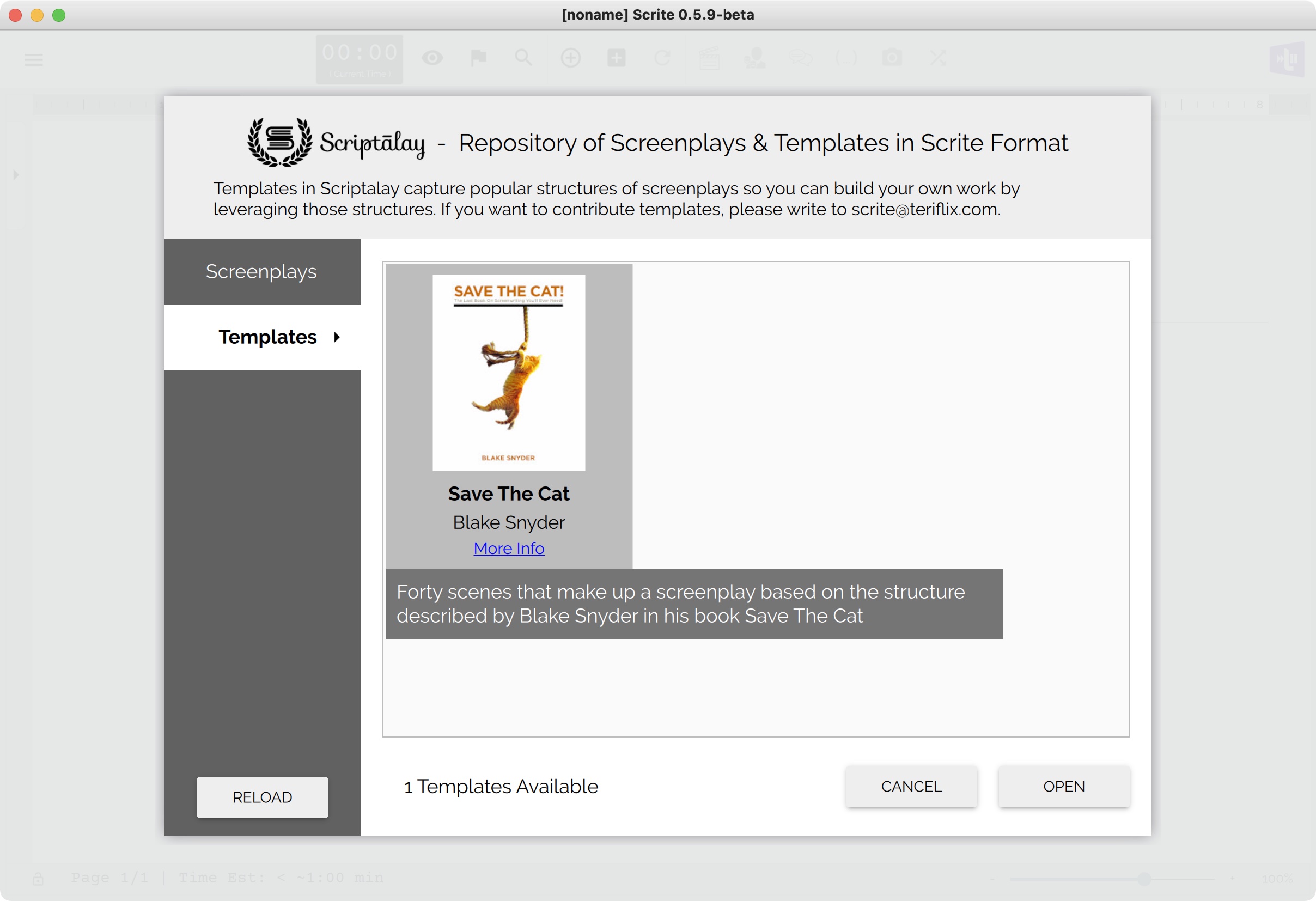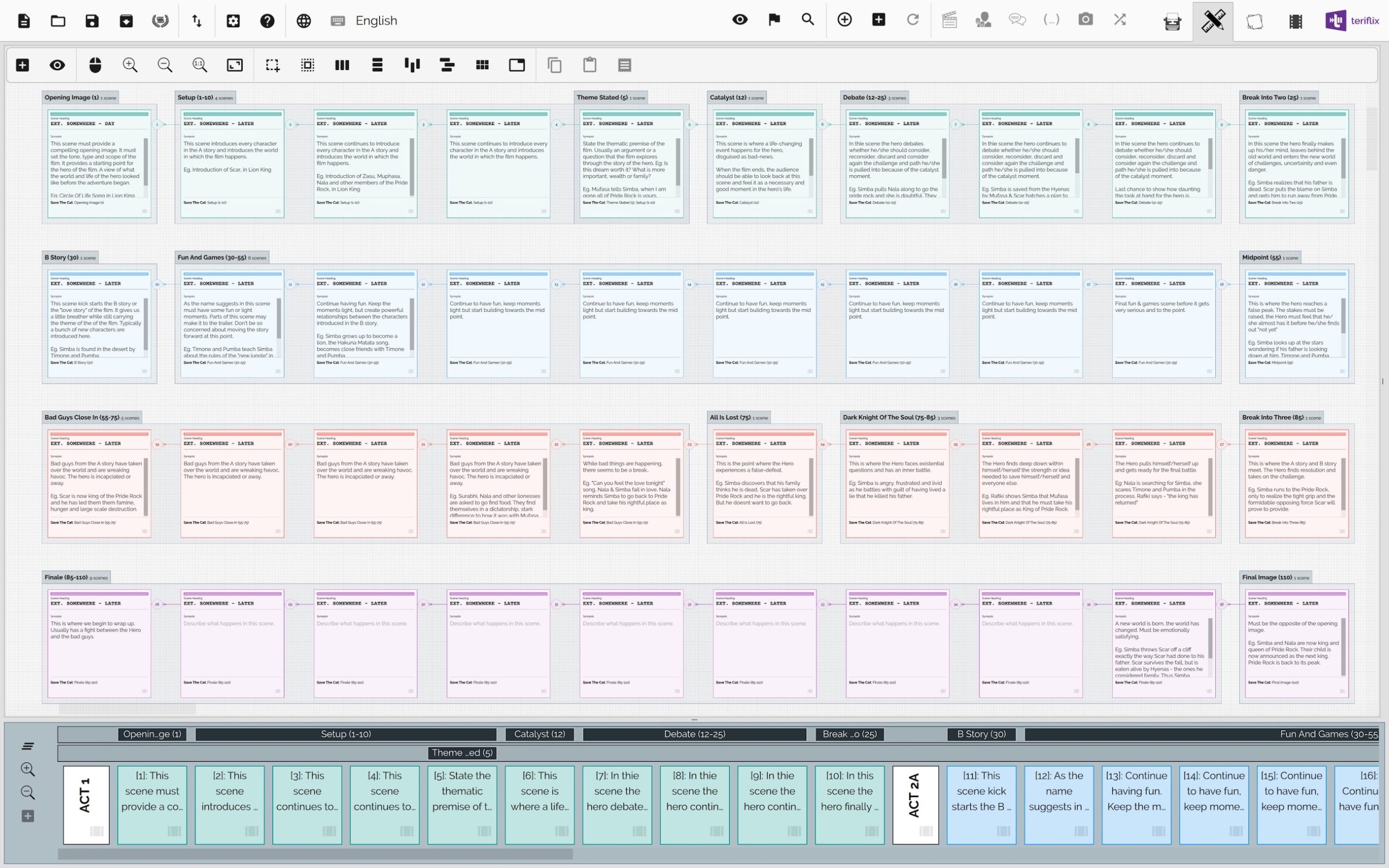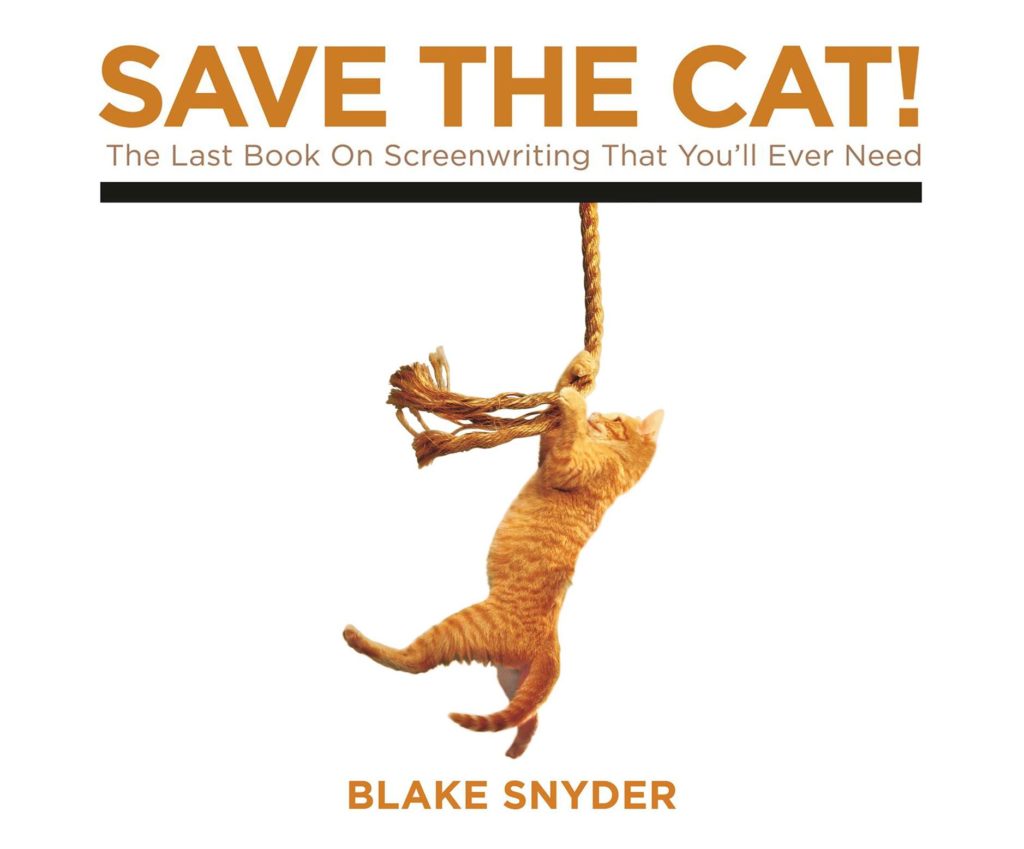Story frameworks help you map out your myriad ideas into a screenplay. In the year 2005, Blake Snyder famously introduced a 15 point beat sheet in his book book “Save The Cat”. It provides a set of 15 clearly defined elements that every screenplay should have. Additionally it also specifies what page or page range each beat should occupy in a typical 110 page screenplay. The beat sheet includes specific beats, or key moments, that should be included in a screenplay, and these beats can help a writer ensure that their story has a clear beginning, middle, and end. The skeleton provided in this book provides a fantastic platform to build screenplays on top of.
You can buy the book from Amazon, a Kindle version is also available. If you’d like to refer to an alternate storytelling framework, you can check out Dan Harmon’s Story Circle.

To illustrate how the Save the Cat beat sheet can be applied in practice, let’s understand the key concepts of the book with the help of four examples. In this post we will attempt to understand how a blockbuster Hollywood movie, an indie Hollywood drama, an all time highest grossing Indian movie, and an Oscar winning South Korean movie – all four can be understood using the 15 beats of the Save the Cat template.
1. Opening Image:
The “Opening Image” is the initial visual or scene in your story that sets the tone, grabs the audience’s attention, and often foreshadows key elements or themes of the narrative. It’s the audience’s first impression of your story.
| The Avengers | Moonlight |
| Opens with the menacing arrival of Loki on Earth, declaring his plan to conquer the planet. | Begins by introducing the young Chiron, who is seen running from bullies. |
| Baahubali | Parasite |
| Starts with a grand spectacle, showcasing a mother and child escaping a military pursuit by climbing a waterfall. | Introduces the Kim family living in a cramped basement apartment, struggling to make ends meet. |
These opening images give an instant mood of your film, from impending conflict to personal struggles.
2. Theme Stated:
The “Theme Stated” beat is a moment early in the story where a character or situation introduces or hints at the overarching themes that the narrative will explore. It provides a glimpse of the deeper messages and ideas at the core of the story
| The Avengers | Moonlight |
| Nick Fury’s unwavering declaration to thwart Loki establishes the movie’s central theme of protecting the world. | The theme of self-discovery and identity is subtly woven into the narrative. |
| Baahubali | Parasite |
| Implicitly states themes of justice, clash of families, and the quest for truth. | Explores themes of class struggle and social inequality through its characters’ lives. |
While some films explicitly state their themes, others, like “Parasite,” rely on subtext and symbolism to convey deeper meanings.
3. Set-Up:
The “Set-Up” phase is the beginning of your story where you establish the characters, their world, and the essential elements necessary for the audience to understand the context of the narrative. It’s the foundation upon which the story is built.
| The Avengers | Moonlight |
| The first act introduces the Avengers individually, providing insight into their person | The first act delves deeply into Chiron’s character, his relationships, and the challenges he faces growing up. |
| Baahubali | Parasite |
| Establishes the rivalry between two brothers, Amarendra and Bhallaladeva, who vie for the throne of the kingdom of Mahishmati. | Paints a vivid picture of the Kim family’s cramped living conditions and their efforts to make a living through odd jobs. |
A good setup can help you write your third act better and create maximum impact by adhering to logical consistencies laid out earlier.
4. Catalyst:
The “Catalyst” is the inciting incident that disrupts the status quo and propels the story into motion. It’s the moment that forces the main character to take action or confront a problem, setting the plot in motion.
| The Avengers | Moonlight |
| Loki’s arrival catalyzes the formation of the Avengers, igniting the storyline. | The arrival of Juan catalyzes Chiron’s journey of self-discovery. |
| Baahubali | Parasite |
| In Baahubali, the discovery of a mysterious baby floating down the river catalyzes a series of events, including the search for the child’s true identity. | The catalyst occurs when Ki-woo gets the opportunity to tutor the daughter of a wealthy family, setting in motion a series of deceptions. |
The catalyst propels the main characters into their respective journeys, driving the narrative forward in each film.
5. Debate:
The “Debate” beat introduces conflicts, dilemmas, or challenges that the characters must grapple with. It often involves discussions or internal struggles, adding depth to their personalities and driving character development.
| The Avengers | Moonlight |
| The Avengers must engage in heated debates about how to confront Loki, adding depth to the characters. | Chiron’s exploration of his sexuality and his complex relationship with Kevin create a debate within himself. |
| Baahubali | Parasite |
| Debates within the royal court about the rightful heir to the throne, highlighting political intrigue. | The Kim family debates the ethics and risks of their deceptions as they infiltrate the wealthy Park family. |
Here, you can explore conflicts that shape the characters’ development. Without a good debate, the conflict of your film may feel flat.
6. Break into Two:
The “Break into Two” beat marks a significant shift in the story. It’s the moment when the main character makes a pivotal decision or takes action that leads them from the setup phase to the main action or adventure of the story.
| The Avengers | Moonlight |
| The pivotal “break into two” beat occurs as the Avengers decide to work collectively as a team, marking the transition to the main action of the movie. | Chiron’s decision to leave home and start anew in Atlanta marks the transition to adulthood and self-discovery. |
| Baahubali | Parasite |
| Amarendra becomes the commander of the kingdom’s army, setting the stage for his journey to reclaim the throne. | The Kim family successfully infiltrates the Park family’s home, initiating their scheme. |
Characters are determined by the actions they take and that makes this beat vital when constructing your screenplay.
7. B Story:
The “B Story” is a subplot that runs alongside the main narrative. It explores secondary themes or character arcs, providing additional layers to the story and characters.
| The Avengers | Moonlight |
| The film subtly weaves in the developing relationship between Black Widow and Hawkeye, adding complexity to the characters. | Chiron’s relationship with his mother serves as a subplot, illustrating how his experiences are shaped by those around him. |
| Baahubali | Parasite |
| The B story involves Amarendra’s budding romance with Devasena, which adds depth to his character | The Kim family’s interactions with the Park family form the B story, revealing contrasting social dynamics. |
The “B story” serves to humanize the characters and provide additional layers to their personalities in each film.
8. Fun and Games:
The “Fun and Games” phase is characterized by exciting, enjoyable, or entertaining moments in the story. It often involves action, adventure, or humor, giving the audience a break from heavy drama.
| The Avengers | Moonlight |
| The middle act showcases action-packed battles against Loki and his forces, delivering thrilling entertainment. | The middle act explores the joys and challenges of Chiron’s life as he grows into adulthood, focusing on emotional depth. |
| Baahubali | Parasite |
| The epic battle sequences, grandiose royal ceremonies, and displays of strength and valour. | The movie uses the middle act to build tension as the Kim family’s deceptions become more complex and precarious. |
While “The Avengers” and “Baahubali” provide action-packed thrills, “Moonlight” and “Parasite” focus on emotional and societal exploration during this phase. Let the genre dictate what the composition of Fun and Games can be.
9. Midpoint:
The “Midpoint” is a critical turning point in the story, often featuring a revelation or event that significantly impacts the characters and plot. It often changes the direction of the story.
| The Avengers | Moonlight |
| The midpoint marks a critical turning point as the Avengers launch their attack on Loki’s base, beginning the final act. | The midpoint is a turning point as Chiron reunites with Kevin, leading to the final act where he confronts his past and future. |
| Baahubali | Parasite |
| The midpoint involves a grand tournament that reveals Amarendra’s prowess and sets the stage for future conflicts. | The midpoint is a revelation that threatens to expose the Kim family’s deception, raising the stakes. |
Often at the midpoint, we see a shift in the narrative into its final phase, introducing pivotal events that shape the characters’ destinies. The journey may take a whole new turn with the help of a surprise or heightened conflict.
10. Bad Guys Close In:
In this phase, tension builds as the antagonist’s plans or threats come closer to fruition. It creates mounting tension and obstacles for the protagonist.
| The Avengers | Moonlight |
| Throughout the story, tension mounts as Loki’s plan inches closer to fruition, intensifying the narrative and excitement. | Chiron faces setbacks and personal challenges as he grapples with his identity and relationships, intensifying his journey. |
| Baahubali | Parasite |
| The bad guys close in as Bhallaladeva schemes to usurp the throne, creating mounting tension. | The bad guys close in as the Kims’ deceptions become more precarious, and the threat of exposure looms large. |
This beat heightens the stakes and obstacles for all the characters, driving the stories toward their climaxes.
11. All is Lost:
The “All is Lost” moment is when it seems that all hope is lost for the protagonist. They face their bleakest point and the most significant obstacles.
| The Avengers | Moonlight |
| The “all is lost” beat arrives when it appears that the Avengers have failed, and Loki seems poised for victory. | Chiron reaches a low point in his life, feeling like he has lost everything. |
| Baahubali | Parasite |
| When Amarendra is unjustly imprisoned, seemingly stripped of his honor and power. | When the Kims’ deceptions are on the verge of being exposed, and chaos ensues. |
In every film there is a moment of despair and self-doubt, the lowest point for the protagonist where literally all hope is lost for them adding depth and emotional resonance to the stories.
12. Dark Night of the Soul:
In this beat, the characters confront their inner demons, personal issues, or doubts. It’s a moment of reflection and transformation for the characters.
| The Avengers | Moonlight |
| The Avengers experience a “dark night of the soul” where they confront their inner demons and personal issues. | Chiron confronts his past and must come to terms with who he is, undergoing a profound transformation. |
| Baahubali | Parasite |
| The “dark night of the soul” involves Amarendra’s imprisonment, testing his resilience and principles. | When the Kims’ deception unravels, leading to a violent confrontation. |
The dark night of the soul moment challenges and transform its characters, preparing them for the climactic resolution.
13. Break into Three:
The “Break into Three” beat marks a shift from the second act to the final act. Characters regroup, adapt their strategies, or make a significant decision as they approach the climax.
| The Avengers | Moonlight |
| In the break into three beat, the Avengers regroup and devise a new plan to thwart Loki. | Chiron must now reconcile his past and forge his future. |
| Baahubali | Parasite |
| The break into three moment involves Amarendra’s escape from captivity, marking the beginning of his quest to reclaim the throne. | The violent and chaotic confrontation between the Kims and the Parks. |
This beat transitions into the final act, where characters must employ all their skills and resources to resolve the conflicts.
14. Finale:
The “Finale” or climax is the most intense and pivotal part of the story. It’s where the central conflict reaches its zenith and is resolved, often with high stakes and action.
| The Avengers | Moonlight |
| The climax is a spectacular battle, pitting the Avengers against Loki and his forces in a high-stakes showdown. | Moonlight: The climax is a poignant and powerful confrontation between Chiron and his past, offering emotional resolution. |
| Baahubali | Parasite |
| The movie delivers an epic finale with large-scale battles and the revelation of long-buried secrets. | It concludes with a shocking and violent climax that brings the film’s themes of class struggle to a head. |
The climax delivers a resolution to the central conflict, whether through action-packed spectacle or emotional catharsis.
15. Final Image:
The “Final Image” is the last visual or scene in your story. It leaves the audience with a lasting impression or feeling, offering a sense of closure or reflection.
| The Avengers | Moonlight |
| We see the heroes emerging victorious, with the world saved and a sense of triumph and fulfillment. | The final image portrays Chiron as a successful and confident adult, offering a hopeful and optimistic note. |
| Baahubali | Parasite |
| Ends with the revelation of Baahubali’s legacy, setting the stage for future adventures. | It concludes with a chilling final image, highlighting the film’s commentary on societal inequality. |
You can add an extra touch to communicate the theme by way of a striking visual or an impactful dialogue which gives the audience an emotional pay off.
By comparing “The Avengers,” “Moonlight,” “Baahubali,” and “Parasite” through the lens of the Save the Cat beat sheet, we can see how this storytelling structure can be applied to a wide range of films. Each film adapts the beats to suit its unique narrative style and themes, demonstrating the versatility of this screenwriting tool.
Starting with version 0.5.9, Scrite lets you download a ready made template based on this book. It consists of 40 empty scenes, neatly segregated into the 15 beats that make up the “Save The Cat” framework.
Just launch Scriptalay after downloading Scrite.

Double click on “Save The Cat” template to download and open it on your computer. When you switch to Structure tab, you can see 40 scenes neatly placed and grouped into “Save The Cat” structure beats.

All you have to do is map your story on to this structure.
Enjoy writing your screenplay!

One reply on “What is Blake Snyder’s Save The Cat Beat Sheet (with Examples)”
This is very helpful. Thank you. Please fix the bugs in the beta version and release the final version without much delay.